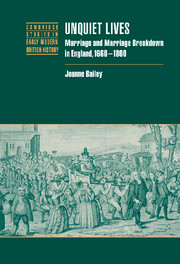Book contents
- Frontmatter
- Contents
- Acknowledgements
- List of abbreviations and conventions
- 1 Introduction: reassessing marriage
- 2 ‘To have and to hold’: analysing married life
- 3 ‘For better, for worse’: resolving marital difficulties
- 4 ‘An honourable estate’: marital roles in the household
- 5 ‘With all my worldly goods I thee endow’: spouses' contributions and possessions within marriage
- 6 ‘Wilt thou obey him, and serve him’: the marital power balance
- 7 ‘Forsaking all other’: marital chastity
- 8 ‘Till death us do part’: life after a failed marriage
- 9 ‘Mutual society, help and comfort’: conclusion
- Appendices
- Bibliography
- Index
- Titles in the series
8 - ‘Till death us do part’: life after a failed marriage
Published online by Cambridge University Press: 27 July 2009
- Frontmatter
- Contents
- Acknowledgements
- List of abbreviations and conventions
- 1 Introduction: reassessing marriage
- 2 ‘To have and to hold’: analysing married life
- 3 ‘For better, for worse’: resolving marital difficulties
- 4 ‘An honourable estate’: marital roles in the household
- 5 ‘With all my worldly goods I thee endow’: spouses' contributions and possessions within marriage
- 6 ‘Wilt thou obey him, and serve him’: the marital power balance
- 7 ‘Forsaking all other’: marital chastity
- 8 ‘Till death us do part’: life after a failed marriage
- 9 ‘Mutual society, help and comfort’: conclusion
- Appendices
- Bibliography
- Index
- Titles in the series
Summary
Couples who stopped cohabiting when they were unable to resolve their marital difficulties became part of a sizeable minority of individuals who lived outside a marital relationship in the later seventeenth and eighteenth centuries. Early in this period 15% of adults never married, though their numbers had declined to 7% by the nineteenth century. Frequent widowhood forced many others to live without a spouse for a period of time, and it became less likely for the widowed to remarry by the later eighteenth century. The numbers of separated spouses joining these groups are difficult to estimate. Pamela Sharpe concludes that 10% of marriages that took place in Colyton, Devon, between 1725 and 1756 ended in separation, but detailed parish reconstitutions of this nature are few and far between. Studies have also counted the numbers of desertions found in the material generated by the settlement laws. Yet this is no indication of total desertion rates within a population, never mind separations not caused by absconding husbands. In general, the types of records which contain information about marriages ending in separation and/or desertion neither are directly comparable nor do they reflect the total incidence of temporary and permanent separations. Though it is impossible to count separated spouses, the records of marital difficulties provide valuable information about the circumstances leading to marriage collapse and the living and working arrangements of spouses thereafter.
- Type
- Chapter
- Information
- Unquiet LivesMarriage and Marriage Breakdown in England, 1660–1800, pp. 168 - 192Publisher: Cambridge University PressPrint publication year: 2003

